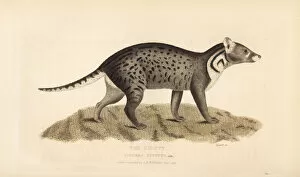Viverra Collection
Viverra, a fascinating genus of mammals, encompasses a diverse group of species that captivate the imagination
All Professionally Made to Order for Quick Shipping
Viverra, a fascinating genus of mammals, encompasses a diverse group of species that captivate the imagination. From the Bewick's Wombat to the East Indian linsang and dhole, these creatures showcase nature's incredible variety. Some members of this family, like the Golden and Asian palm civets, are known for their unique ability to produce highly sought-after coffee beans through an interesting digestive process. However, not all viverras receive such attention. The Aardwolf and Large Indian civet face threats as they teeter on the brink of endangerment. Similarly, the African civet and Striped skunk also struggle to survive in their respective habitats. In Madagascar resides one particularly elusive member: the Malagasy civet or Fossa fossana. This enigmatic creature is shrouded in mystery due to its secretive nature. Meanwhile, both Asian palm civets and African civets share similarities despite being from different continents. The Viverra genus also includes lesser-known species such as greater grison and Sunda stink badger which play vital roles within their ecosystems. Additionally, let us not forget about Viverra fossa or Fossane - an intriguing carnivore found exclusively in Madagascar. To further appreciate these remarkable animals' significance throughout history, we can look back at an engraving from 1855 depicting a Viverra genet. It serves as a reminder that our fascination with these creatures spans centuries. Viverra showcases nature's ingenuity by encompassing various species with distinct characteristics and ecological roles. As some face endangerment while others remain elusive mysteries waiting to be unraveled; it is crucial that we continue our efforts towards conservation to ensure their survival for generations to come.




















